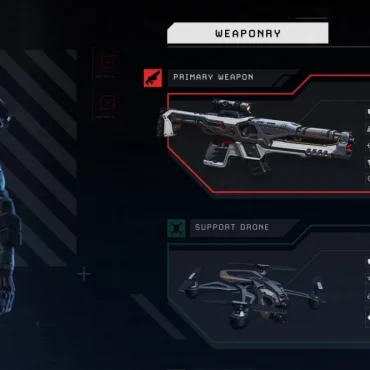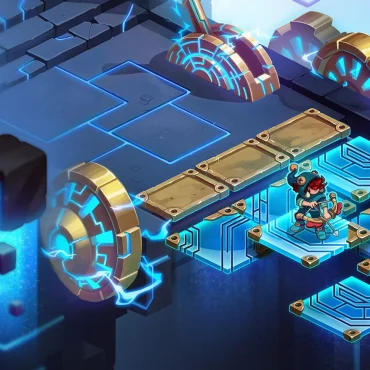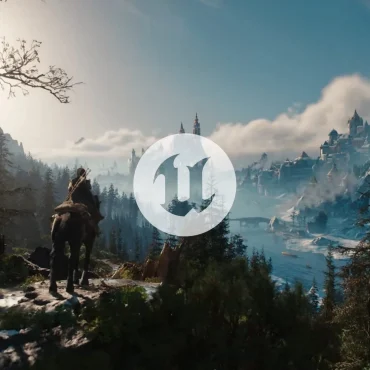Even without the recent controversy that sparked over Unity, porting projects from Unity to Unreal Engine is not a novelty. Developers have been doing it for nearly a decade, aiming to enhance the visual quality of their projects and leverage innovative features introduced by Epic Games.
The whole ‘porting’ concept however is often misunderstood and treated like it is similar to porting a game from PC to Xbox, for instance. In reality, it is more of a ground-up recreation of your project with the same vision but quite a different set of tools. So if you initiated your project in Unity and are currently wondering how to port a game into Unreal, or questioning whether it’s a move worth considering, this article is a read for you.
Why do many prefer Unreal Engine to Unity?
Most of our clients who wanted us to help them smoothly transition to Unreal were looking first and foremost for unparalleled graphical fidelity and superior rendering capabilities that the engine offers. With Unreal Engine’s robust tools and features, games often achieve a more immersive, cinematic experience, attracting players and investors, ultimately leading to greater commercial success.
Transition to another engine is a considerable step that may take months to complete, but the benefits you will harness may be just worth it. Here are some of the most notable advantages Unreal Engine offers:
Graphical fidelity
When migrating a game from Unity to Unreal Engine, one of the most striking things will be an immediate boost in graphical fidelity. While it’s indeed possible to craft stunning visuals within Unity that can rival Unreal’s, it will be more resource-consuming. Unreal, on the other hand, delivers superior visual quality right from the outset. You can create beautiful scenes with less effort as well as benefit from a number of advanced graphical tools like:
Lumen: Lumen stands as Unreal Engine 5’s dynamic solution for achieving more lifelike global illumination and responsive reflection systems. It readily adapts to changes within the scene, rendering diffuse inter-reflection with infinite bounces and indirect specular reflections in vast, intricate environments, spanning from millimeters to kilometers. With this feature, games will no longer be limited by a static world – making it easier for Unreal Engine developers to perform iterations and create more accurate and lifelike lighting, reflections, and shadows.
Nanite: Nanite is a 3D graphics rendering method that renders only the details that the viewer can perceive. Developers can import cinematic-quality assets directly into Unreal Engine scenes without the need for optimization, level of detail (LOD) models, or normal maps. Also, Nanite meshes render faster and use less memory and disk space. This not only makes the image sharper but also streamlines asset creation and scene management.
Niagara particle system: Unreal Engine offers advanced particle systems for creating high-quality visual effects (VFX). The Niagara plugin introduces grid simulation to the engine that allows adding realistic smoke, fire, explosions, fluid, splashes, and many other physically plausible effects to your projects.
Forward rendering: Unity and Unreal Engine both employ forward rendering, which renders objects individually with direct lighting calculations. However, they differ in their lighting models, shader languages, material workflows, and post-processing flexibility. Unreal uses a combined approach of deferred rendering and forward rendering to speed up the calculation of lighting on the scene. In general, Unreal’s forward rendering is better optimized for mobile and VR devices, excelling in delivering sharp visuals.
Terrain and landscape tools: Unreal Engine also has great built-in terrain and landscape tools that allow developers to create vast and detailed game worlds with realistic terrain deformation and foliage systems. Unity in this regard often relies on third-party assets, and you must go the extra step to achieve the same result as Unreal has out of the box.
MetaHumans
With Unreal Engine’s MetaHuman Creator tool, you can quickly produce highly realistic 3D human models. This tool comes with a library of pre-built animations, encompassing a broad spectrum of movements, emotions, and gestures, and allows capturing facial animations in real time.
The MetaHuman Creator tool simplifies character customization. Developers can tweak various parameters, such as facial expressions, body proportions, and clothing, reducing the need for extensive character modeling and animation work. And despite their incredible visual fidelity, benefiting from Unreal’s physically-based materials, high-quality textures, and dynamic lighting, MetaHumans are optimized for real-time performance.
Blueprint visual scripting
Unreal Engine’s Blueprint Visual Scripting system is a powerful tool for both programmers and designers, making it easier to create and manage game logic and interactions. Key points to consider include:
- Visual Node-Based System: Blueprint uses a node-based visual scripting system, making it accessible to those without strong programming backgrounds, while still offering flexibility and complexity.
- Intuitive Debugging: The Blueprint system features robust debugging tools, allowing developers to identify and fix issues more efficiently during the development process.
- Integration with C++: Unreal Engine allows seamless integration between Blueprints and C++ code, ensuring that complex logic can be written in code while still benefiting from the ease of use of Blueprints.
- Rich Library of Nodes: Unreal Engine provides an extensive library of pre-built nodes, reducing the need for custom scripting and speeding up development.
Additional advantages
Chaos Physics: Unreal Engine boasts a robust physics simulation system, surpassing Unity in many aspects. Its Chaos Physics system offers highly realistic and complex simulations of objects, destruction, and interactions.
World Partition: Unreal Engine’s World Partition System is a game-changer for open-world game development. This system efficiently manages vast game worlds by dynamically loading and unloading sections as needed, improving performance and enabling seamless exploration.
Build-in Systems: When migrating a game from Unity to Unreal, you can significantly reduce the reliance on third-party plugins due to Unreal Engine’s array of built-in features. These include:
- A multiplayer framework that simplifies the creation of online and local multiplayer.
- Behavior Tree that streamlines the development of complex AI behaviors, making it easier for developers to create responsive and intelligent in-game characters.
- A built-in Automation Testing to facilitate the testing process.
Open Source: Unreal has an open engine code, so we can change/add to it as we like, shaping it to fit our project’s needs.
The porting process itself
Now that we know why people often prefer Unreal to Unity, let’s talk about the porting process itself. Migrating a game from Unity to Unreal Engine is far from a straightforward “porting” process. In reality, it entails a comprehensive recreation of the game within another engine, owing to the fundamental differences in architecture, scripting languages, and underlying philosophies between Unity and Unreal Engine.
Porting 3D assets and animations
The first question we often hear is “Can I use Unity assets in Unreal Engine?” Yes, absolutely. The transfer of 3D assets and animations from Unity to Unreal Engine is a critical aspect of migration. Fortunately, Unreal Engine is versatile in handling a wide range of asset formats. Standard formats like FBX, OBJ, and even textures in PNG or TGA are compatible with both Unity and Unreal Engine.
Textures, which are essential for defining the appearance of 3D models, can be readily imported into Unreal Engine. The engine supports a variety of texture types, including diffuse, normal maps, roughness, and metallic maps, which align with Unreal’s physically-based rendering (PBR) system.
Recreating shaders, a crucial aspect of translating a game’s visual style, may require more effort. If you’re acquainted with Unity’s ShaderGraph, transitioning to Unreal’s Material Editor should be relatively smooth. Unreal’s Material Editor offers a node-based system, akin to ShaderGraph, with added capabilities for advanced rendering effects, enabling enhanced visual fidelity.
Code porting from Unity to Unreal
The transition of code from Unity to Unreal Engine is a fundamental but demanding task in the porting process. Unity employs C# as its primary scripting language, while Unreal Engine relies heavily on C++. The languages differ significantly in their syntax and the way they interact with the engines. Additionally, Unity and Unreal Engine have contrasting core architectures, from GameObjects and Components in Unity to Actors and Components in Unreal Engine. The workflows, asset management, and even the way assets are structured and organized diverge substantially. So understanding this architecture is vital for efficient code porting. While the transition can initially be challenging, once you acclimate to Unreal’s coding practices and its frameworks, the recreation of code can proceed more rapidly, particularly if your original code is modular and well-organized.
Ensuring proper documentation and version control is crucial throughout this process to facilitate collaboration and mitigate potential code-related issues down the line.
Custom tools/plugins porting
Unity’s custom editor scripts are closely tied to the Unity Editor API, which does not have a direct counterpart in Unreal Engine. As a result, custom tools need to be entirely reworked to function within Unreal’s Editor framework.
The complexity and extent of custom tooling in your Unity project play a substantial role in determining the effort required for this transition. The key to a successful port is evaluating the necessity and functionality of existing tools. Some simpler custom tools may be recreated more efficiently within Unreal Engine using its Blueprint Visual Scripting system, while more complex tools may require extensive coding and debugging.
It’s imperative to maintain a clear understanding of Unreal Engine’s unique Editor framework, including the Asset Editor, Level Editor, and Blueprint Editor, to adapt your custom tools effectively. Careful planning, documentation, and rigorous testing are essential components of this process to ensure a smooth and efficient transition of custom tools and plugins.
Wrapping up
In essence, the “porting” process primarily revolves around converting Unity assets to Unreal Engine – 3D models, textures, audio files, and the like. These assets can be reused with modifications, but the core game logic, character controls, camera systems, and much of the gameplay elements have to be rewritten from scratch. From the programmer’s standpoint, the journey from Unity to Unreal Engine isn’t simply a relocation but a reimagining of the game’s core mechanics, behaviors, and systems to align with Unreal’s principles and capabilities, making it more akin to a full-scale game development project within a new environment.
Game porting with N-iX Game & VR Studio
When undertaking the complex task of porting a game to Unreal Engine, enlisting the expertise of a seasoned development partner can make the transition smoother and more efficient. With 11+ years of hands-on knowledge in game development, N-iX Game & VR Studio possesses a deep understanding of both Unity and Unreal Engine. This expertise ensures a seamless transition, from asset migration and code rewriting to custom tool recreation. So, if you are looking for a committed and experienced partner, drop us a line.





